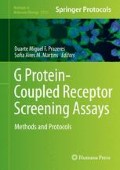Abstract
The spatiotemporal characterization of protein–protein interactions is essential to understand nearly all cellular events. Several methodological strategies derived from noninvasive luminescence- and fluorescence-based approaches allow the detection of specific protein–protein interactions in living cells. Here, we describe the application of bioluminescence resonance energy transfer (BRET) and donor fluorescent recovery after photobleaching (dFRAP) approaches to the study of G protein-coupled receptor (GPCR) oligomerization. These technologies alone – or in combination with complementary methods – can become extremely powerful approaches for visualizing these cellular protein–protein interactions, even between more than two proteins. Overall, these methods might become extremely important tools in GPCR drug discovery.
Access this chapter
Tax calculation will be finalised at checkout
Purchases are for personal use only
References
Eglen RM (2005) Emerging concepts in GPCR function – the influence of cell phenotype on GPCR pharmacology. Proc West Pharmacol Soc 48:31–34
Ferré S, Casadó V, Devi LA et al (2014) G protein-coupled receptor oligomerization revisited: functional and pharmacological perspectives. Pharmacol Rev 66:413–434. doi:10.1124/pr.113.008052
Ciruela F, Vallano A, Arnau JM et al (2010) G protein-coupled receptor oligomerization for what? J Recept Signal Transduct Res 30:322–330. doi:10.3109/10799893.2010.508166
Vilardaga J-P, Agnati LF, Fuxe K, Ciruela F (2010) G-protein-coupled receptor heteromer dynamics. J Cell Sci 123:4215–4220
Selbach M, Mann M (2006) Protein interaction screening by quantitative immunoprecipitation combined with knockdown (QUICK). Nat Methods 3:981–983. doi:10.1038/nmeth972
Ciruela F (2008) Fluorescence-based methods in the study of protein-protein interactions in living cells. Curr Opin Biotechnol 19:338–343. doi:10.1016/j.copbio.2008.06.003
Ciruela F, Vilardaga J-P, Fernández-Dueñas V (2010) Lighting up multiprotein complexes: lessons from GPCR oligomerization. Trends Biotechnol 28:407–415
Förster T (1948) Zwischenmolekulare energiewanderung und fluoreszenz. Ann Phys 2:55–75. doi:10.1002/andp.19484370105
Cardullo RA (2007) Theoretical principles and practical considerations for fluorescence resonance energy transfer microscopy. Methods Cell Biol 81:479–494. doi:10.1016/S0091-679X(06)81023-X
Stryer L, Haugland RP (1967) Energy transfer: a spectroscopic ruler. Proc Natl Acad Sci U S A 58:719–726. doi:10.1073/pnas.58.2.719
Ciruela F, Fernandez-Duenas V, Llorente J et al (2012) G protein-coupled receptor oligomerization and brain integration: Focus on adenosinergic transmission. Brain Res 1476:86–95, doi: 10.1016/j.brainres.2012.04.056; 10.1016/j.brainres.2012.04.056
Canals M, Burgueno J, Marcellino D et al (2004) Homodimerization of adenosine A2A receptors: qualitative and quantitative assessment by fluorescence and bioluminescence energy transfer. J Neurochem 88:726–734, doi: 2200 [pii]
Fernandez-Duenas V, Gomez-Soler M, Jacobson KA et al (2012) Molecular determinants of A(2A) R-D(2) R allosterism: role of the intracellular loop 3 of the D(2)R. J Neurochem 123:373–384. doi:10.1111/j.1471-4159.2012.07956.x
Acknowledgments
This work was supported by grants SAF2011-24779, Consolider-Ingenio CSD2008-00005, and PCIN-2013-019-C03-03 from Ministerio de Economía y Competitividad and ICREA Academia-2010 from the Catalan Institution for Research and Advanced Studies to F.C. Also, the authors belong to the “Neuropharmacology and Pain” accredited research group (Generalitat de Catalunya, 2014 SGR 1251).
Author information
Authors and Affiliations
Corresponding author
Editor information
Editors and Affiliations
Rights and permissions
Copyright information
© 2015 Springer Science+Business Media New York
About this protocol
Cite this protocol
Ciruela, F., Fernández-Dueñas, V. (2015). GPCR Oligomerization Analysis by Means of BRET and dFRAP. In: Prazeres, D.M.F., Martins, S.A.M. (eds) G Protein-Coupled Receptor Screening Assays. Methods in Molecular Biology, vol 1272. Humana, New York, NY. https://doi.org/10.1007/978-1-4939-2336-6_10
Download citation
DOI: https://doi.org/10.1007/978-1-4939-2336-6_10
Published:
Publisher Name: Humana, New York, NY
Print ISBN: 978-1-4939-2335-9
Online ISBN: 978-1-4939-2336-6
eBook Packages: Springer Protocols

